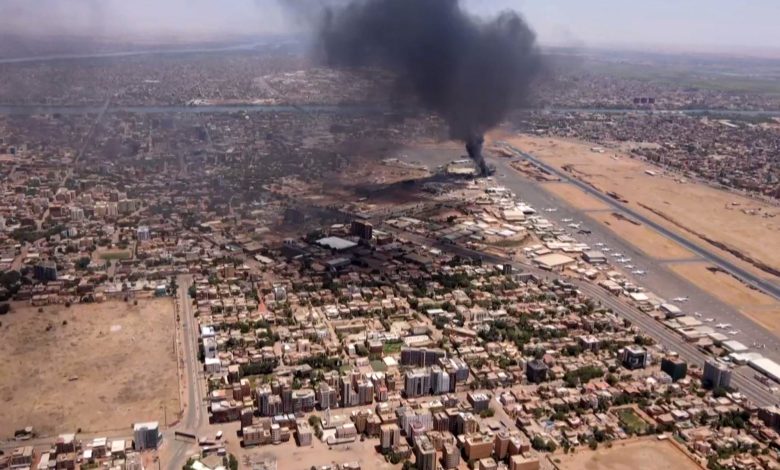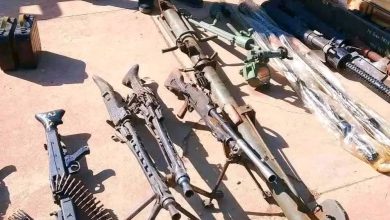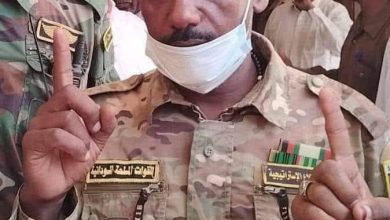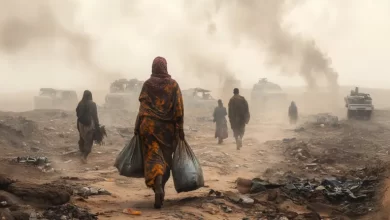Sudan War: A Report on the Hottest Battle Zones in Khartoum

Report by Fath Al-Rahman Shabarqa
Several battlefronts in the Sudanese capital, Khartoum, are witnessing intense clashes, with the Sudanese army holding the initiative in high-stakes battles against the Rapid Support Forces (RSF), which continue to retreat under heavy strikes from the army and its allied forces.
Below is an overview of the key active battle zones in Khartoum:
Central Khartoum
The fierce battles raging in Khartoum can be divided into several sectors, with Central Khartoum being one of the most critical and volatile. This area has been witnessing heavy fighting with various types of weapons, both light and heavy, as of Thursday morning.
Key battlegrounds include government ministry areas, prominent landmarks, the Arab Market, and the Friendship Hall, which recently caught fire—indicating an RSF retreat similar to their withdrawal from the Khartoum Oil Refinery, leaving behind fires and heaps of ashes.
The confrontations also persist around the Republican Palace, which has been the scene of some of the fiercest battles since the army broke the siege on its General Command on January 24. The palace holds significant symbolic value, making control over it a key objective.
Southern Khartoum
Several neighborhoods in southern Khartoum remain battlegrounds, particularly areas near the Armored Corps headquarters, such as Al-Rimaila, Jabra, and Al-Sahafa, extending to the outskirts of Jebel Aulia. The fighting is expected to expand in the coming days to include Kalaklat, Al-Shegilab, Mayo, and Al-Azhari, as well as the Central Reserve Forces base, whose recapture by the army would pave the way for liberating additional territories along the Khartoum-White Nile border.
The Sudanese army’s recent advances in various combat zones have caused panic among RSF forces stationed in southern, eastern, and central Khartoum. According to eyewitnesses, this has led to thousands of RSF fighters fleeing towards Darfur via Jebel Aulia.
East of the Nile & Soba Bridge
Active battles are ongoing in different areas east of the Nile in Khartoum State. The army has secured Soba Bridge from the eastern side, while RSF forces hold the western side. The army is determined to gain full control of the bridge due to its strategic importance in the current military operations, as it serves as a gateway to southern Khartoum.
The army’s Sudan Shield Forces, led by Major General Abu Aqila Keikel, have played a significant role in the battle since they unexpectedly joined government forces in October 2024. In recent days, they have managed to seize control of Wad Abu Salih, Umm Duwaban, Al-Aseilat, and Al-Ailafun in Khartoum State’s East Nile locality.
Securing Soba Bridge would give the army a critical advantage, tightening its grip on one of Khartoum’s key crossings and further isolating RSF forces in a confined area where supplies would be difficult to reach, leaving them vulnerable to army fire from multiple directions.
Approaching the Capital
The army is advancing from Gezira State, pushing toward Khartoum via Soba. Meanwhile, the 1st North Gezira Brigade is nearing the border between Gezira and Khartoum states.
Intermittent clashes are ongoing in Betri, the last point north of Gezira State, bordering Khartoum. Many expect the army to decisively settle the battle at the outskirts of Khartoum at any moment.
In recent days, the army has liberated several strategic locations, including Al-Bagir, Al-Masaoudiya, Al-Takina, Al-Nuba, Al-Maileq, Wad Al-Turabi, and the Giad Industrial City.
Omdurman Clashes
The army’s recent successes have confined battles to specific areas within Khartoum State.
In Omdurman, where the army achieved early military victories, current clashes are concentrated in the western neighborhoods of Karari locality, around Souq Libya, and parts of Umbada locality. Additionally, Al-Salha, located south of Omdurman, remains a contested zone, housing one of the largest RSF camps.
Battles in Khartoum North (Bahri)
The Sudanese army has taken control of old Bahri, along with several neighborhoods such as Halfaya, Al-Doroshab, Al-Samrab, and Shambat. However, fighting continues in eastern Bahri, particularly in the eastern blocks of Kafouri and some neighborhoods near East Nile.
Military analysts suggest that the RSF has lost much of its solid power in Khartoum and can no longer rely on its previous strategy of overwhelming enemy forces with reinforcements—commonly referred to as the “Fazaa” tactic—which they have used throughout the war to either rescue trapped forces or seize new territory.
However, ongoing clashes in various battlefronts demonstrate that the RSF still possesses the capability to strike key infrastructure, including water and electricity stations, using drones. Meanwhile, the Sudanese army’s air force continues to provide a decisive advantage, offering air cover for advancing ground troops.
Shifting Battle Lines
By examining the key battle zones across Khartoum’s three cities—Khartoum, Khartoum North (Bahri), and Omdurman—it is evident that the Sudanese Armed Forces are gradually tightening their siege on the capital. A complete recapture of the city seems inevitable, with some analysts considering it a matter of time.
Nonetheless, some speculate that the RSF might resort to desperate military maneuvers, such as setting fire to vital state facilities, to signal that they still maintain some military leverage.
Additionally, battle zones and territorial control remain fluid and dynamic, constantly shifting based on military advancements. Given the Sudanese army’s recent momentum, it is highly likely that they could achieve decisive victories across multiple fronts in the capital in the near future.
Source: Al Jazeera Net



